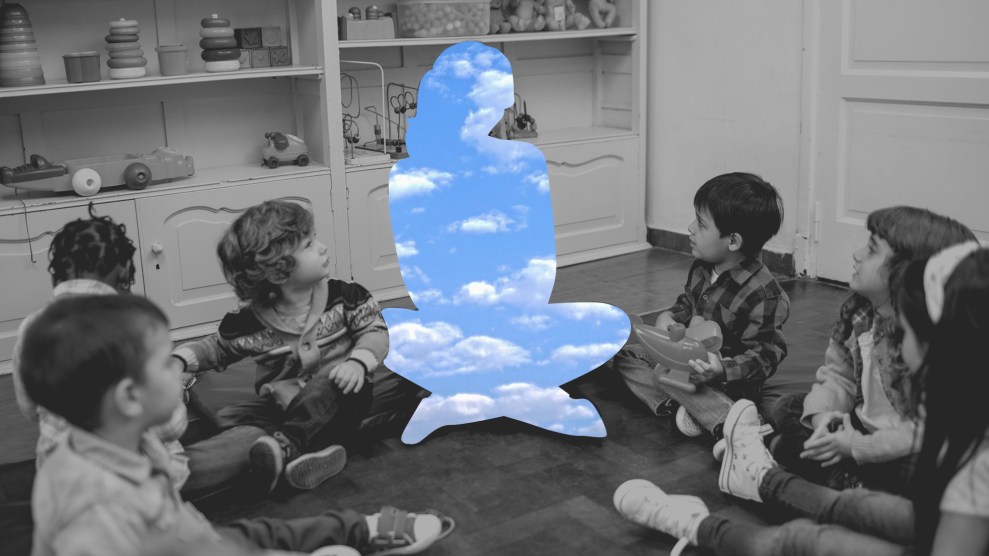
Mother Jones illustration; Getty
In February 2021, the federal government sent a $24 billion lifeline to day care centers to keep them afloat amid a still-raging pandemic. When that funding expires on September 30, 3.2 million children are likely to lose their child care spots, the Century Foundation predicts.
Among them may be some of the 94 kids who currently attend Melissa Colagrosso’s A Place To Grow Children’s Center in Oak Hill, West Virginia. The funding Congress appropriated through the American Rescue Plan Act and its child care stabilization grant program played a key role in helping Colagrosso pay down her business loans—which accrued to some $100,000 over 25 years of operating an at-capacity day care center—while also enabling her to provide her staff members with $400-per-month paycheck bonuses and funding for tuition assistance to further their early childhood education training. The incentives encouraged her to staff to stay put. In turn, she was able to keep serving the same number of children.
Now that the federal funding is ending, so too are the perks she was able to offer employees—and perhaps, their willingness to stay onboard. “Four hundred dollars might be a car payment,” Colagrosso says of the money her staff won’t be receiving anymore. “There could be some people that have to look around and go, ‘I love this job, but Sheetz pays more.’”
At 54 years old, Colagrosso says she won’t go back into the red to retain staff, as much as it breaks her heart. “If we get back to where we can’t make payroll,” she says, “I’ll start cutting classrooms.”
That Colagrosso’s finances were so shaky pre-pandemic wasn’t an indication she was bad at business. Rather, it was a byproduct of what Susan Gale Perry, the CEO of the advocacy organization Child Care Aware of America, calls a “broken business model”—and one that Congress seems unlikely to fix before the September 30 financial cliff.
Childcare centers are legally required to maintain strict adult-to-child ratios, which makes the industry have high labor costs. Maintaining high staffing levels often means paying staff low wages, relative to other service industries. Nationally, the median wage for a childcare provider is just $13.71 per hour, according to the Bureau of Labor Statistics.
“I say a broken business model, because really, the cost to provide this service is out of reach for most families, and the people doing the work still aren’t making a wage that they can take care of their own families,” says Perry.
The solution isn’t as simple as centers raising tuition, especially in lower-income areas. Already, the average family pays more than $10,000 annually in child care costs. In Colagrosso’s center, 78 percent of children are from low-income families that qualify for a federal program that pays Colagrosso a lower tuition rate based on a sliding scale. In order to make up for the lower rates coming from those families, she can raise rates on families paying full tuition, but not by so much that they are priced out of care.
“The whole system is really just broke,” says Colagrosso. Broke, as in broken. But also as in fresh-out-of-cash.
The report by the Century Foundation, a liberal think tank, estimates that the expiration of funding will likely cause 70,000 programs to close. Many of those that don’t shutter will have hard decisions to make. “Childcare businesses are going to be in a terrible position of having to either raise the rates that parents are paying for childcare even higher, making it even more out of reach for families; or reduce the wages of their childcare teachers, meaning that more childcare teachers are likely to leave the field,” says Perry. “If teachers aren’t in classrooms, then classrooms can’t be open.”
More than 232,000 child care jobs are on the line, the report says. And while the researchers predict parents who can’t find child care for their kids will collectively miss out on $9 billion annually in lost earnings, a crumbling childcare sector will hurt more than just daycare workers and parents of young children.
“If millions of parents can’t go to work, businesses can’t find the workers they need to operate. And if businesses cut back because they can’t find workers, then national productivity and economic growth suffer,” Sen. Elizabeth Warren (D-Ma.), said during a recent hearing of the Senate Banking Committee’s Subcommittee on Economic Policy.
As the funding nears its expiration date, Senators including Patty Murray (D-Wash.) and Bernie Sanders (I-Vermont) and Democratic Reps. Katherine Clark of Massachusetts and Rosa DeLauro of Connecticut have introduced a stopgap bill to appropriate $16 billion of funding to extend the Child Care Stabilization program over the next five years.
“The child care industry holds up every sector of our economy,” Murray said in a statement, “and Congress must act now.”
Meanwhile, Congress is struggling to fund basic government functions, let alone a large childcare outlay. Hard-line Republicans are stonewalling attempts by Democrats and moderate Republicans to pass a funding bill before money at most federal agencies runs out on Saturday.
The most likely solution to avoid a government shutdown—though still far from guaranteed—is passing a continuing resolution, which would temporarily fund the government and give lawmakers extra time to pass a more permanent, omnibus budget package later on. Theoretically, the $16 billion in proposed child care funding could be tacked onto a continuing resolution, or the more permanent bill.
But both options would cost money—something Republicans are trying to cut.
“In principle, folks are for more government support [of the child care industry],” Rep. Ro Khanna, who launched a bipartisan child care caucus earlier this summer, told Mother Jones last week. “But it’s going to be a challenge to see if we can get the Republicans to support it when their own caucus is calling for 8 percent across-the-board cuts.”













